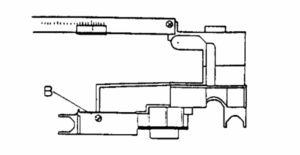Forum Replies Created
-
AuthorPosts
-
 BRONZE Member
BRONZE MemberMost of the time with these models it is an issue with the ribbon cables between the main board and the other ones including the keypad. I would carefully reflow all of the connections on each cable end. I would also check if your 2MHz clock is running on Pin 11 of IC1.
 BRONZE Member
BRONZE MemberIn the first instance I have bought a new DIN to RCA cable from Sounds Heavenly as it does seem that B&O pins are wired differently – fingers crossed this works… will keep you posted!
Thanks so much again, Emma
Emma, if you get sound but have a hum using the Sounds Heavenly cable, return it and get one that has a separate ground wire that you connect to the thumb screw on your phono preamp. I included an example in my previous reply.
 BRONZE Member
BRONZE MemberYou need a Phono DIN adapter cable to go into your preamp such as this one: https://www.av-connection.com/?PNo=AV-DINPHONO&gad_source=1. The one you’re using is likely connected to the wrong pins and also needs the ground wire.
 BRONZE Member
BRONZE MemberOn a turntable that old, if its motor is not turning then the grease has hardened and bearings dried out. You never posted what is actually not working.
 BRONZE Member
BRONZE MemberThat is simply a chassis ground.
 BRONZE Member
BRONZE MemberI’m not sure which wire you believe is totally missing. If you are referring to the Red/Black twisted pair in the first picture that appears unconnected, that is normal for 1000’s not equipped with a phono PC board. Yours simply has the jumper board that directly connects the tonearm cable to the output cables which then go into a preamp’s phono inputs. What is actually not working?
 BRONZE Member
BRONZE MemberThat capacitor is not your problem. You say you don’t have voltage at the 01C1 5V regulator. Does this mean that you measure 0V at both its input and output? If that is the case can you check the continuity of the F1 fuse? If it is good that means you have no output out of the diode bridge and its supporting capacitors. That’s where I would focus.
 BRONZE Member
BRONZE Member BRONZE Member
BRONZE MemberYour problem is not simply the knob. That amount of damage would have destroyed the arm bearing so that even if you could get the knob in the arm would damage records.
 BRONZE Member
BRONZE MemberThanks for the pictures. I’m afraid that level of tonearm bearing damage is not repairable.. You will need to replace the tonearm to restore the turntable. Many of these have bad motors so you may find one for parts that you can use its tonearm.
 BRONZE Member
BRONZE MemberDieter, I’m not following your description. Assuming you have a 1200, the rear counterweight when screwed fully in is factory to the tracking force as there was no user adjustment on that model. Perhaps you can post a picture.
 BRONZE Member
BRONZE MemberLooks like someone did a nice hack job. Here is a link to a picture with all the wires on the correct pads: https://archivedforum2.beoworld.org/cfs-filesystemfile.ashx/__key/CommunityServer.Components.PostAttachments/00.00.12.47.75/bg8000_5F00_din_5F00_pcb_5F00_01.jpg
 BRONZE Member
BRONZE MemberYou need to connect the black lead to a chassis ground which is available many places. For example, the negative terminal of C24 or C27.
 BRONZE Member
BRONZE MemberFirst I would double check that All of the replaced capacitors are in the correct polarity. After plugging in, you should see a red dot in the display. If you are not getting that I would check that you have 5VDC at pin P6-1 which is powering the CPU, then work backwards to the Zener and regulator.
 BRONZE Member
BRONZE MemberIt appears that the arm is being blocked from moving inward once it lowers. I would check with it open and lowering the arm to the right of the platter. It should move freely the 1/2 inch to the sensor arm. Sometimes the optical shutter is sticking or has be rotated so it hits its stop prematurely.
 BRONZE Member
BRONZE Member BRONZE Member
BRONZE MemberAs Dillen replied 0TRi is mounted on a metal block heat sink screwed to the bottom and connected to the board on the solder-side. You can easily measure the voltage across it while pressing the start button to see whether it is passing 22V which is shorthand for “22 volts”. This is my last message to you on this as your combative responses and insistence that you did nothing to cause this non-operation are preventing a successful diagnosis and my help.
 BRONZE Member
BRONZE MemberThere is no harm in adding that jumper as it is simply connecting two ground points together. These boards being single-sided used jumpers all over the place to connect grounds together.
 BRONZE Member
BRONZE MemberPaul, yes the LED you posted in the second picture is an OP160 IR LED; however, I was addressing the Beolover picture that you posted earlier and the visibly lit areas. This LED however, is not the source of your problem. If you are not getting any response from pressing Start then you are likely not getting 1TR1 turning on 0TR1 so that 22v is sent to activate the arm motor circuit. If you are looking for a troubleshooting flowchart, you can upgrade your membership to Silver and get access to the 4002 service manual which has that chart.
 BRONZE Member
BRONZE MemberPaul, we appear to have a language issue as I don’t understand what you mean by “plugging in the tray into a 20-Volt outlet”. There are no IR diodes in this model as the end fixed arm light logo and the tonearm movement optical shutter all use incandescent bulbs.
I previously asked you to perform specific tests which you have not reported on and I need this info to assist further. If after plugging into the wall and pressing Start nothing happens, then you may have blown a fuse which is located in the back right hand corner in a black plastic box.
You have done things to the table that are totally unnecessary such as removing the control panel and its PC board and the result can be breaking something. It is also easy to misalign the board connectors and cause problems. How much experience do you have working on electronics and reading and understanding circuit diagrams?
-
AuthorPosts


